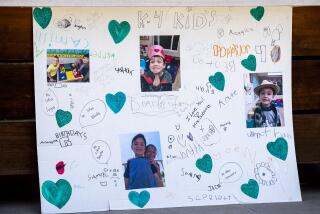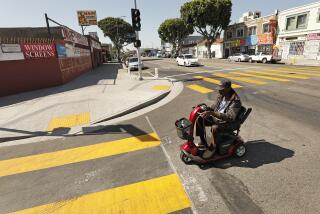Seat Belts: The Message Has to Click
I didn’t want to write about seat belts in this column. Because we all know seat belts save lives. Nothing left can be said that’s fresh and new, right?
But at a recent public health conference in South San Francisco, I met Diana Bonta, the new director of the state’s Health Care Agency. It was clear from discussions with statewide public health officials that Bonta is revered as a leader in this field.
But she almost didn’t live long enough to take the job. When I met her, she told this story:
She’d been nominated by Gov. Gray Davis last summer. At the time, she was health care director for the city of Long Beach, one of only three municipalities in the state with such an agency. Now the top job in the field was hers, an exciting step in her career.
But on a Saturday last fall, while her husband and son had gone shopping, Bonta headed for her Long Beach office. It was the kind of lazy Saturday she loved; with the office empty, she could catch up on some of her work.
But driving there, she was caught completely unaware as her vehicle was broadsided by another driver who ran a light.
Bonta wound up with numerous injuries, including a broken collarbone. It took months to recover. But it could have been much worse.
“That seat belt saved my life,” she said. “Thank God for that seat belt.”
Living proof to her, when she finally got the seat belt off, she felt immediate pain shoot through her shoulder. The seat belt had been holding her together.
Here’s just a few basic facts about safety belts:
* About 45,000 people each year die in vehicular accidents, says the National Safety Council. About half could have been saved by wearing seat belts.
* The National Highway Traffic Safety Administration says only 68% of drivers and passengers in this country wear seat belts, while 95% do in Canada and Western Europe.
* A University of Pittsburgh study found that seat belt usage could have reduced spinal injuries in vehicular accidents by 37%.
* Children follow a parent’s example. A UC Irvine study published in the journal Pediatrics found that if a driver wore a seat belt, a child in the vehicle was three times more likely to wear one too.
* In New York, according to the state’s safety campaign, lack of seat belts was a greater cause of vehicle deaths than either alcohol or excessive speed.
A study by Oklahoma State University’s safety training center showed that one of the main arguments people gave for not wearing a seat belt is “I’m afraid the belt will trap me in the car.” But the study adds: “Statistically, the best place to be during an accident is in your car. If you’re thrown out, you’re 25 times more likely to die.”
The weekend after I met Bonta, I contemplated whether my readers really wanted another lecture on seat belts. But then that Sunday morning, Andre Stewart, 18, a record-setting football hero at Newport Harbor High School, was killed in a car crash. He lost control and his vehicle ran into a guardrail.
Stewart’s brother, Lamar, a passenger, escaped with minor injuries.
Lamar was wearing a seat belt. Andre was not.
Maybe it’s an issue in which you cannot repeat the message often enough. Not everyone gets the word.
Buckle up. For yourself.
*
Jerry Hicks’ column appears Monday and Thursday. Readers can reach Hicks by calling (714) 966-7789 or e-mail to jerry.hicks@latimes.com.






